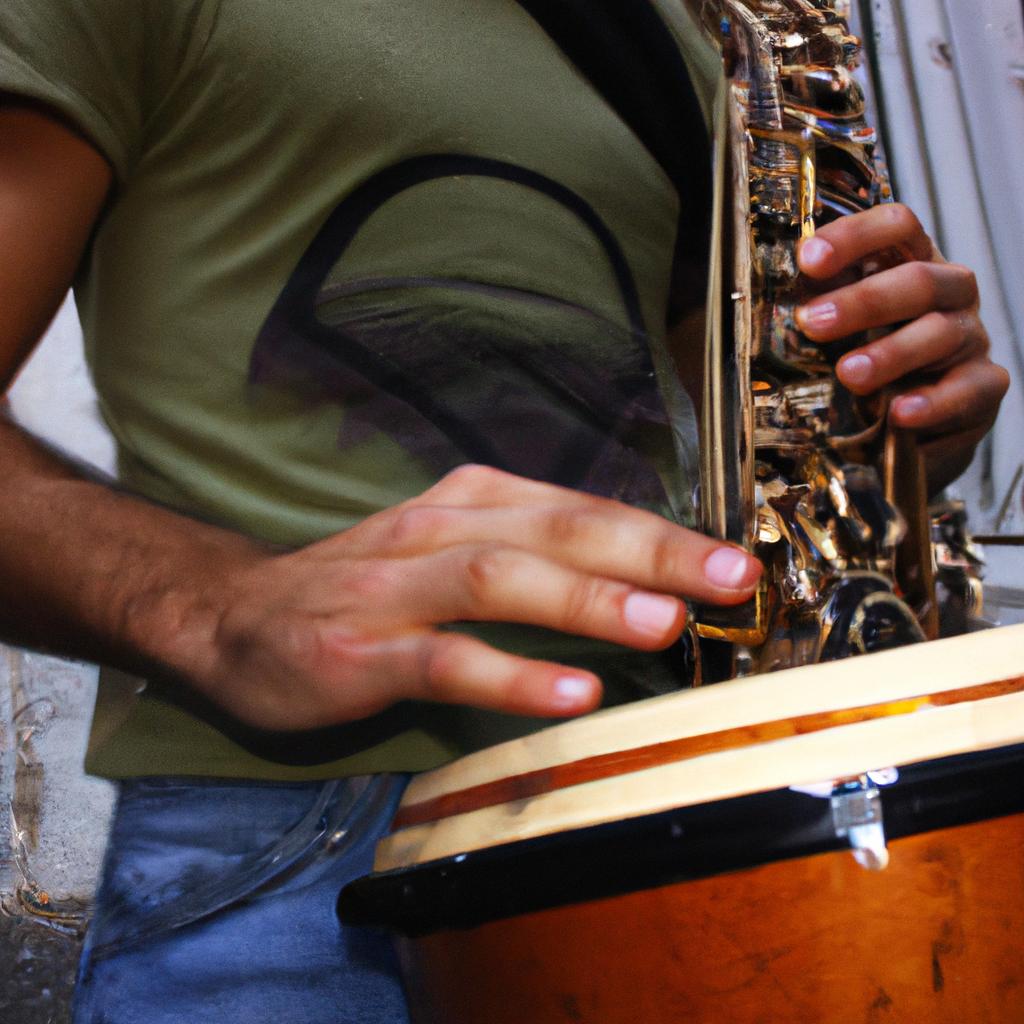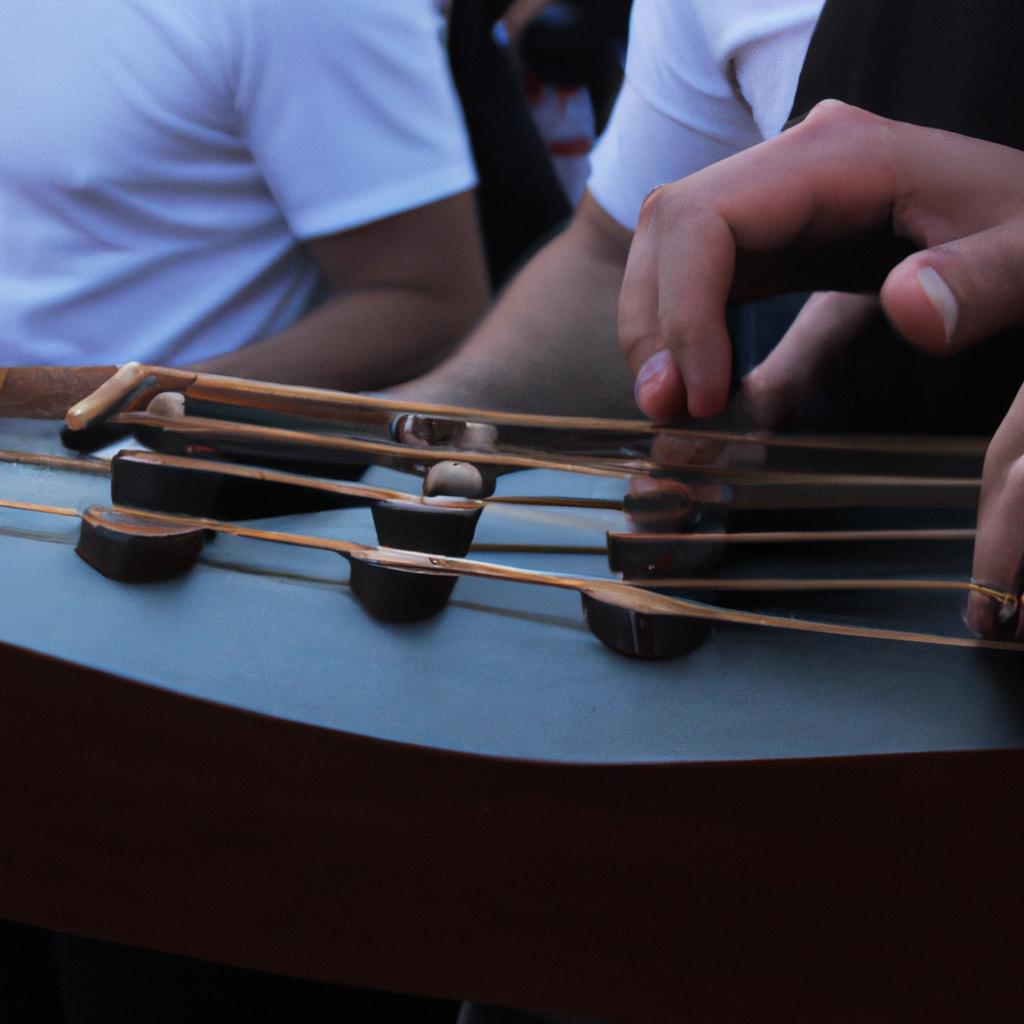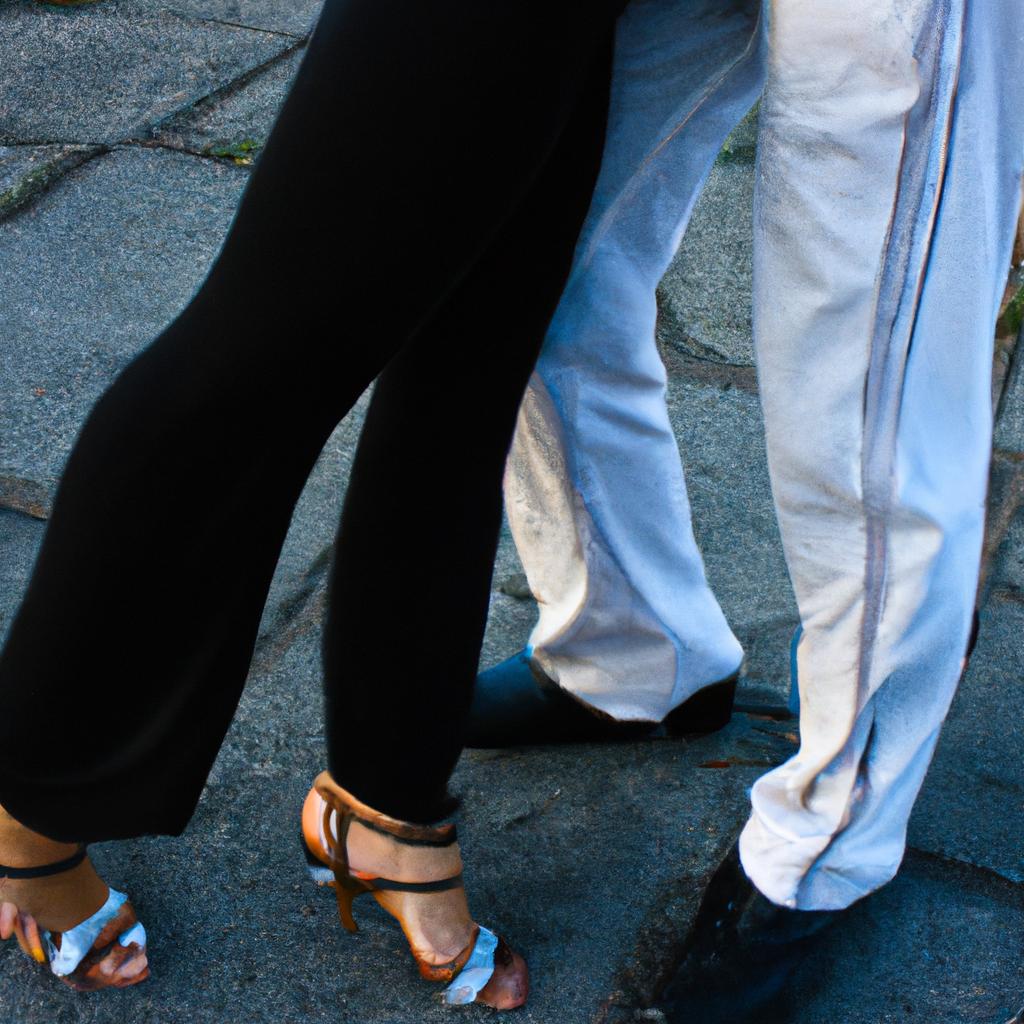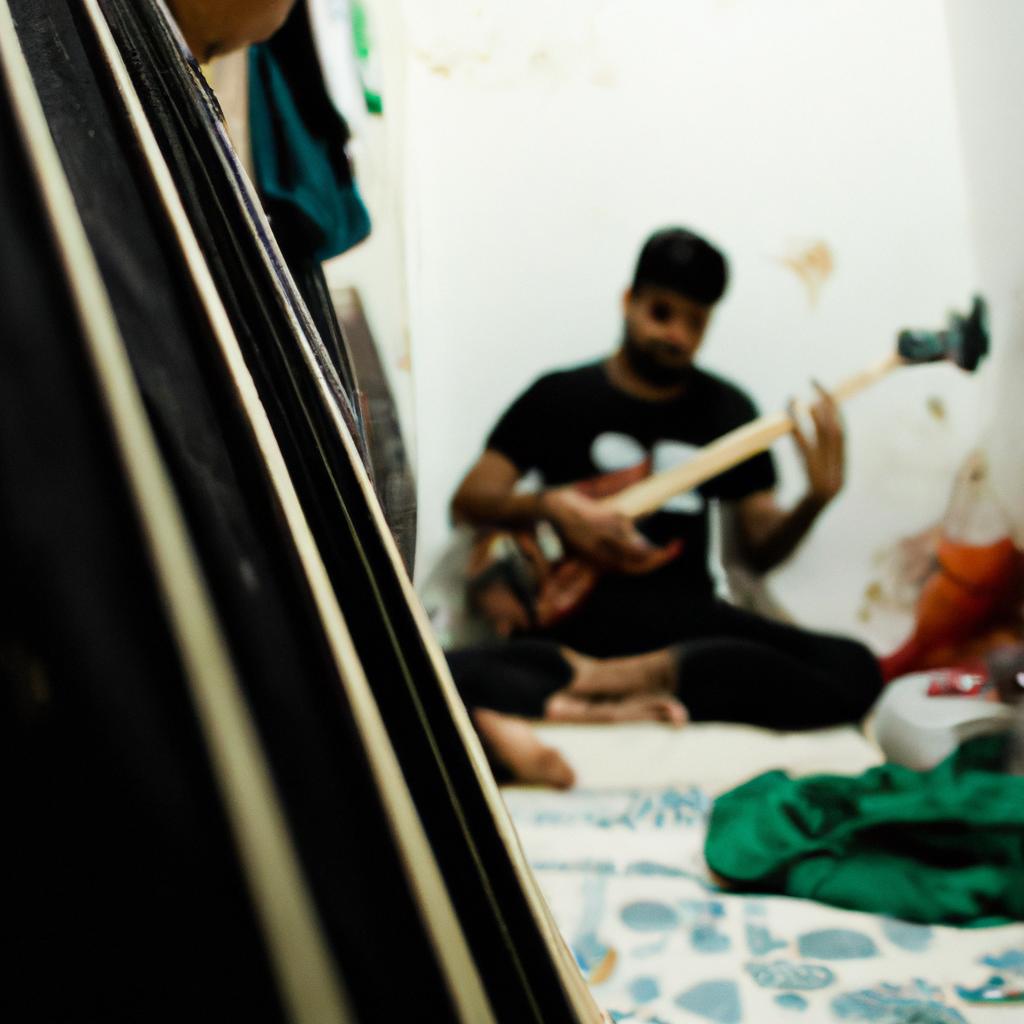Vibrato, a widely utilized technique in tango instrumentation, adds depth and expressiveness to the music. This article aims to explore the significance of vibrato in enhancing the emotional impact of tango melodies by analyzing its usage across various instruments commonly found within the genre. To illustrate this concept, let us consider a hypothetical scenario: imagine a passionate bandoneon player performing an evocative tango piece. As their fingers glide over the buttons, they skillfully manipulate the pitch with subtle fluctuations through vibrato, infusing each note with a captivating intensity that resonates with listeners on a profound level.
Tango is renowned for its ability to evoke intense emotions such as passion, longing, and melancholy. The use of vibrato plays a pivotal role in achieving this effect by adding nuances of expression to instrumental performances. Vibrato refers to the slight oscillation or variation in pitch produced by musicians when playing sustained notes. By employing controlled variations in pitch frequency and amplitude, performers can create a rich tapestry of sound that embodies the inherent drama and sensuality characteristic of tango music. Whether it be through strings vibrating under skilled bowing techniques or breathy inflections achieved on wind instruments, vibrato serves as an essential tool for conveying the complex range of emotions found within tango melodies.
In tango, the bandoneon, a type of accordion, is often considered the heart and soul of the ensemble. The bandoneon player’s adept use of vibrato can elicit intense emotions from listeners. As they manipulate the buttons and air flow, their fingers produce subtle fluctuations in pitch that create a sense of longing or desire in each note. This vibrato technique allows the bandoneon player to express the raw passion and vulnerability inherent in tango music.
Similarly, string instruments such as the violin and cello bring their own unique character to tango melodies through vibrato. By applying slight variations in finger pressure and bowing speed, skilled string players can infuse each sustained note with a luscious vibrancy. This adds depth to the melody, giving it an emotional richness that resonates with listeners. Vibrato on strings can convey both the yearning and melancholy aspects of tango music, allowing performers to immerse themselves fully in its expressive power.
Wind instruments like the flute or saxophone also benefit from employing vibrato techniques in tango performances. By subtly manipulating embouchure or breath control, wind musicians can create a warm and sensuous sound that complements the passionate nature of tango melodies. Vibrato on wind instruments adds a human-like quality to the music, evoking feelings of intimacy and connection between performer and listener.
Overall, vibrato serves as a powerful tool for enhancing the emotional impact of tango music across various instruments. It allows performers to convey a wide spectrum of emotions ranging from longing and desire to melancholy and introspection. Through controlled variations in pitch frequency and amplitude, vibrato brings depth, expressiveness, and an authentic human touch to tango melodies – captivating audiences with its ability to evoke profound emotions.
The History of Vibrato in Tango Music
Imagine yourself transported to a dimly lit bar in Buenos Aires, where the sultry sounds of tango fill the air. As you listen closely, you notice the subtle nuances that give this music its distinct flavor – one of which is vibrato. This technique, characterized by slight variations in pitch and intensity, has played a significant role in shaping the sound of tango music throughout its history.
Vibrato’s presence in tango can be traced back to the early 20th century when musicians began experimenting with ways to add depth and emotion to their performances. One notable example is Astor Piazzolla, an Argentine composer and bandoneon player who revolutionized tango music through his innovative use of vibrato. Piazzolla’s expressive playing style became synonymous with the genre itself, attracting both acclaim and controversy among traditionalists.
To better understand the impact of vibrato on tango instrumentation, let us delve into some key aspects:
-
Emotional Intensity: With vibrato, musicians are able to infuse their performances with heightened emotional intensity. The subtle fluctuations in pitch create a sense of longing or melancholy that resonates deeply with listeners.
-
Expressive Phrasing: Vibrato provides an opportunity for musicians to shape their phrases dynamically. By employing controlled variations in intensity, they can emphasize certain notes or passages, adding richness and complexity to their interpretation.
-
Artistic Individuality: Every musician brings their own unique approach to using vibrato. Some may prefer a wide and dramatic oscillation while others opt for a more restrained tremor-like effect. This diversity allows for self-expression within the boundaries of tradition.
-
Collaborative Interaction: In group settings such as tango orchestras or ensembles, vibrato serves as a means of communication between instrumentalists. It enables them to blend harmoniously together while also highlighting individual voices within the ensemble.
Considering the historical significance and emotional impact of vibrato in tango music, it is evident that this technique holds a special place within the genre. In the subsequent section, we will explore how different styles of vibrato have emerged over time, further enriching the tapestry of tango instrumentation. By examining these variations, we can gain deeper insights into the evolution of this captivating musical tradition.
Different Styles of Vibrato in Tango Instrumentation
Transition from the Previous Section
Having explored the historical development of vibrato in tango music, we now turn our attention to the various styles employed in its instrumentation. By examining these different techniques, we can gain a deeper understanding of how vibrato contributes to the unique expressiveness and emotional depth found within this genre.
Different Styles of Vibrato in Tango Instrumentation
To illustrate the diverse range of vibrato styles utilized in tango instrumentation, let us consider an example: a bandoneón player performing a passionate solo during a milonga. The skilled musician employs subtle variations in vibrato technique, enhancing the overall emotional impact of their performance. These stylistic choices are influenced by factors such as regional traditions, personal interpretation, and individual artistic expression.
One must note that there is no definitive classification system for categorizing the numerous styles of vibrato found in tango instrumentations. However, certain common characteristics emerge when analyzing a variety of performances across different time periods and regions. Here are some notable examples:
- Lyrical Vibrato: Exhibiting a smooth and flowing quality, this style aims to create an expressive melodic line with gentle oscillations.
- Intense Vibrato: Characterized by rapid fluctuations and pronounced amplitude, this style conveys heightened emotion and dramatic intensity.
- Tremolo-like Vibrato: Resembling a trembling effect rather than traditional vibrational motion, this style adds a dynamic texture to the sound.
- Subtle Vibrato: Employing minimalistic movements with slight pitch deviations, this understated approach adds nuance without overpowering the musical phrases.
To further comprehend the distinctions between these styles, refer to the table below which highlights their key features:
| Style | Characteristics |
|---|---|
| Lyrical Vibrato | Smooth flow; gentle oscillations |
| Intense Vibrato | Rapid fluctuations; pronounced amplitude |
| Tremolo-like Vibrato | Trembling effect; dynamic texture |
| Subtle Vibrato | Minimalistic movements; slight pitch deviations |
By exploring these diverse styles of vibrato, we can appreciate the artistic choices that contribute to the rich tapestry of tango music. Each musician brings their unique interpretation and personal style, resulting in a captivating range of expressiveness within this genre.
Transition to the Subsequent Section
Understanding the different techniques employed in tango instrumentation allows us to delve deeper into the significance of vibrato in expressing emotion. Let us now explore how vibrato serves as a crucial tool for evoking intense feelings and capturing the essence of tango’s emotional landscape.
The Importance of Vibrato in Expressing Emotion in Tango Music
Transitioning from the previous section that discussed different styles of vibrato in tango instrumentation, we now delve into the importance of this technique in expressing emotions within tango music. To illustrate its significance, let us consider a hypothetical scenario: imagine a passionate tango performance where the violinist employs a rich and expressive vibrato throughout their solo. The audience is captivated by the emotional depth conveyed through this subtle yet powerful technique.
Vibrato plays an integral role in evoking various emotions within tango music. By incorporating controlled fluctuations in pitch and intensity, it adds layers of complexity to the melodic lines, resonating directly with the listener’s feelings. Here are some ways in which vibrato contributes to emotional expression:
- Intensifying Romanticism: Vibrato can enhance the romantic essence inherent in tango music by creating a sensuous and longing atmosphere. As notes quiver and tremble under the influence of vibrato, listeners experience heightened emotions of desire, passion, and yearning.
- Conveying Melancholy: In certain melancholic passages of tango compositions, vibrato takes on a mournful quality that elicits deep sadness or nostalgia. The gentle wavering effect produced by vibrato reinforces these bittersweet sentiments that resonate with both performers and audiences alike.
- Infusing Drama: Vibrato has a dramatic impact on tango music when utilized during climactic moments or tense sections. A well-executed wide and intense vibrato can intensify tension and create suspense, leaving listeners on edge as they anticipate what comes next.
- Expressing Joy and Celebration: Not limited to somber moods alone, vibrato also finds its place in exuberant dance rhythms characteristic of joyous tango pieces. When employed judiciously, lighter forms of vibrato can add sparkle and liveliness to melodies, enhancing the festive spirit associated with upbeat tempos.
To further understand how vibrato affects emotional expression in tango music, consider the following table:
| Emotion | Vibrato Technique |
|---|---|
| Passion | Rich and expressive vibrato throughout phrases |
| Longing | Slow and subtle vibrato with wider variation in pitch |
| Sadness | Gentle and mournful vibrato with controlled intensity |
| Tension | Intense and wide vibrato during climactic moments |
As we can see from this example, different emotions within tango music demand varying approaches to vibrato technique. The ability to manipulate these nuances effectively allows musicians to convey a broad range of feelings through their instruments.
In the subsequent section about “Common Instruments in Tango Music That Utilize Vibrato,” we will explore how vibrant vibrations are utilized across various instruments, showcasing their individual contributions to the overall texture of tango compositions.
Common Instruments in Tango Music That Utilize Vibrato
Transitioning from the significance of vibrato in expressing emotions within tango music, it is crucial to understand the various techniques employed by musicians to achieve this effect. By examining different approaches to vibrato, we can gain a deeper appreciation for its versatility and impact on the overall musical experience.
Consider a hypothetical scenario where a violinist performs an intense tango piece using vibrant and expressive vibrato techniques. The use of wide and slow oscillations accentuates the emotional depth of each note, creating a captivating performance that resonates with the audience. This example highlights how varied vibrato techniques contribute to the richness and intensity of tango music.
To further explore these techniques, let us examine some common methods employed by instrumentalists when incorporating vibrato into their performances:
- Wide Oscillation: Musicians may choose to employ wider oscillations during more passionate or dramatic sections of a composition, intensifying the emotional impact on listeners.
- Narrow Oscillation: Conversely, narrower oscillations are often utilized during softer passages or moments requiring delicate expression, providing subtlety and nuance.
- Gradual Increase: A gradual increase in vibrato speed as a phrase progresses can add tension and anticipation, heightening emotional engagement.
- Sudden Intensity: Suddenly increasing the intensity of vibrato at specific moments can create dramatic emphasis or evoke particular emotions such as anguish or yearning.
To better visualize these techniques’ contributions to tango music’s emotive qualities, consider the following comparison table showcasing typical scenarios where certain types of vibrato might be applied:
| Vibrato Technique | Musical Effect | Example Scenario |
|---|---|---|
| Wide Oscillation | Heightened intensity | Climactic section in a passionate tango melody |
| Narrow Oscillation | Subtle expressiveness | Soft interlude in a melancholic tango composition |
| Gradual Increase | Tension and anticipation | Building towards an emotional peak in a tango piece |
| Sudden Intensity | Dramatic emphasis or yearning | Expressing heartache during a poignant tango solo |
In conclusion, exploring the various vibrato techniques used in tango music reveals how instrumentalists can effectively convey emotions and intensify musical experiences. By incorporating wide oscillations for heightened intensity or narrow oscillations for subtle expressiveness, musicians skillfully navigate the nuances of each composition. Additionally, gradual increases in vibrato speed create tension, while sudden bursts of intensity evoke specific emotions. Understanding these techniques allows performers to craft captivating performances that resonate deeply with their audience.
Transitioning into the subsequent section about “Tips for Developing a Strong Vibrato Technique in Tango,” we delve further into practical advice on mastering this expressive technique within the realm of tango instrumentation.
Tips for Developing a Strong Vibrato Technique in Tango
In the previous section, we discussed the common instruments in tango music that utilize vibrato. Now let’s delve deeper into the role of vibrato in tango music performances and its impact on the overall musical expression.
Imagine a scenario where two violinists are performing a passionate tango piece. The first violinist plays with a flat, unvarying tone while the second violinist incorporates a subtle yet expressive vibrato technique. As you listen to their performance, you can immediately discern the difference in emotional depth conveyed by each musician. The use of vibrato adds warmth, intensity, and an element of longing to the melody, creating a captivating experience for the audience.
To better understand how vibrato enhances tango music performances, consider these points:
- Expressive nuances: Vibrato allows musicians to infuse their playing with subtle variations in pitch and timbre. By oscillating between notes within a sustained tone, performers can convey emotions such as yearning or desire, which are integral to capturing the essence of tango music.
- Dynamic contrast: Through controlled manipulation of vibrato speed and width, musicians can create contrasting textures within their phrases. This variation adds richness and dimension to their interpretation, enabling them to evoke both tender moments and fiery passages characteristic of tango music.
- Connection with vocal style: Tango is known for its intimate connection with human emotion and often features lyrical elements through vocal accompaniment. Incorporating vibrato techniques on string instruments bridges this gap between voice and instrument, allowing instrumentalists to emulate the expressiveness found in singing.
Now let’s further explore how different instruments utilize vibrato techniques in tango music performances by examining some examples:
| Instrument | Vibrato Technique | Effect |
|---|---|---|
| Bandoneon | Subtle fluctuations in pitch | Adds a haunting and melancholic quality to the sustained notes |
| Piano | Controlled oscillation of whole chords | Creates a sense of rhythmic pulsation and enhances harmonic richness |
| Double Bass | Vibrato with wider amplitude | Provides a warm, resonant foundation for the melody |
| Guitar | Quick and precise vibrato on individual notes | Brings out the passionate and percussive elements in tango rhythm |
By understanding how different instruments utilize vibrato techniques and their effects on musical expression, musicians can further enhance their performances in capturing the essence of tango music.
Transitioning into our next section about “Exploring the Role of Vibrato in Tango Music Performances,” let us embark upon an exploration of how this technique intertwines with other aspects of tango instrumentation.
Exploring the Role of Vibrato in Tango Music Performances
Transitioning smoothly from the previous section that discussed tips for developing a strong vibrato technique in tango, we now delve into exploring the role of vibrato in tango music performances. To illustrate its significance, let us consider an example: imagine a passionate tango performance where every note played on the violin is infused with a subtle yet expressive vibrato, enhancing the emotional impact of the music.
Vibrato serves as a vital tool for musicians to add depth and emotion to their performances. In tango music specifically, this technique plays a crucial role in conveying the intense and passionate nature of the genre. By employing controlled variations in pitch through oscillating movements of the finger or hand, vibrato adds warmth and color to each note, bringing life to melodies while allowing performers to express their own artistic interpretation.
To better understand how vibrato contributes to the overall effect of tango music, here are some key aspects worth considering:
-
Emotional resonance: Vibrato has the power to evoke deep emotions within listeners by imbuing notes with character and intensity. It can create a sense of longing, melancholy, or even joyousness depending on how it is employed. The gentle fluctuations in pitch produced by vibrato allow musicians to shape phrases dynamically, eliciting powerful responses from audiences.
-
Connection between instruments: In ensemble settings such as tango orchestras or small ensembles, vibrato helps establish a harmonious connection among different instruments. When used collectively across various sections like strings or woodwinds, it creates a unified sound that enhances cohesion and gives richness to the overall musical texture.
-
Artistic expression: Vibrato provides instrumentalists with an opportunity for individual expression within tango music performances. Musicians can adapt their use of vibrato based on personal style and interpretation, adding unique nuances and subtleties that contribute to their artistic identity and distinguish them from other performers.
-
Enhancing rhythmic elements: While tango music is renowned for its rhythmic complexities, vibrato can help soften and smooth out the edges of sharp staccatos or syncopated accents. By introducing a gentle undulation to sustained notes, vibrato contributes to a more fluid and connected musical experience.
To further illustrate these points, let us consider the following table showcasing different emotions conveyed through varying degrees of vibrato:
| Emotion | Vibrato Style |
|---|---|
| Passionate | Wide and intense |
| Melancholic | Moderate width |
| Joyful | Light and fast |
| Introspective | Subtle tremolo |
In conclusion, vibrato plays an integral role in tango music performances by adding emotional depth, connecting instruments within ensembles, allowing artistic expression, and enhancing rhythmic elements. Its ability to convey various emotions makes it an indispensable technique for musicians aiming to captivate audiences with passionate tango renditions.




